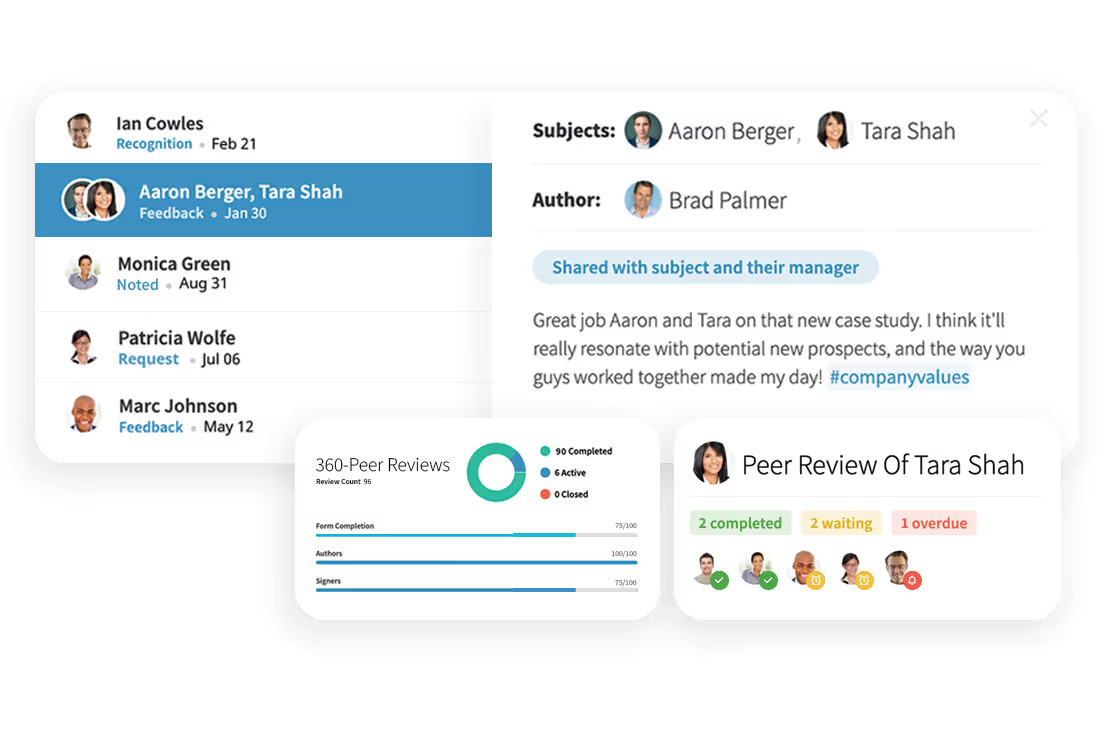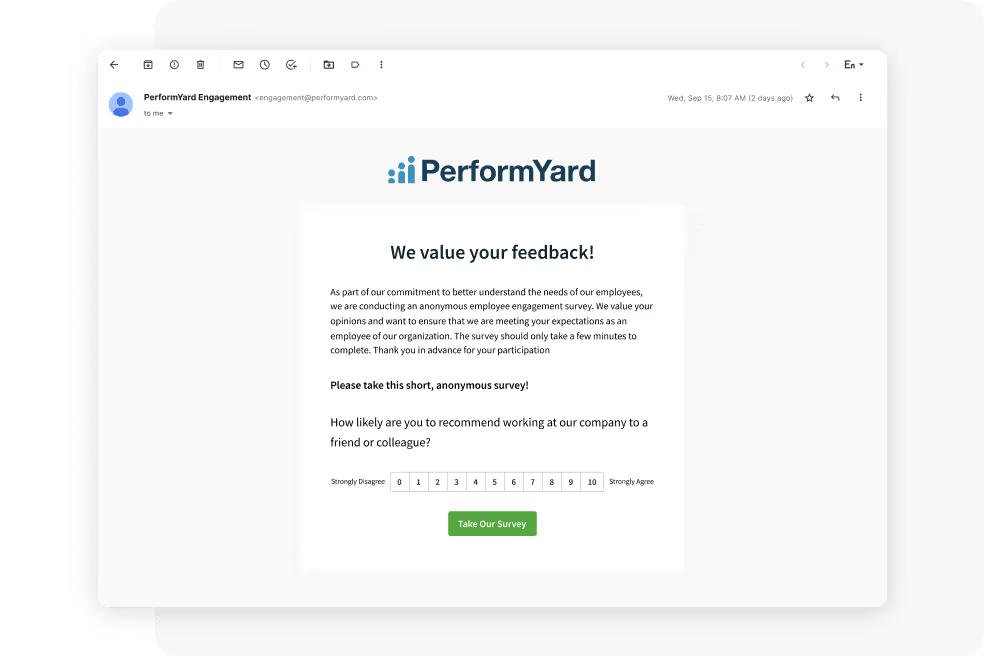How to Improve Employee Satisfaction - 15 Examples
Employee satisfaction may be intangible, but it holds considerable value in the workplace. It drives engagement, productivity, and profits. In a competitive job market, being an organization that values its employees’ emotions and well-being is a great way to separate yourself from the competition.
However, improving employee satisfaction is no simple task. It involves creating many methods and programs that focus on employee recognition, work-life balance, and so much more.
In this article, we’ll explore what employee satisfaction is, practical ways to enhance it, and how different tools can be leveraged to create a happier, more motivated workforce.
What is Employee Satisfaction?
Employee satisfaction refers to the level of contentment employees feel regarding their jobs and workplace environment. It encompasses a range of factors, such as job responsibilities, work-life balance, recognition, company culture, relationships with supervisors and colleagues, and growth opportunities.
Having high employee satisfaction shows that individuals feel positive about their roles and the organization as a whole. High satisfaction leads to increased motivation, loyalty, and productivity. It’s a key indicator of how well a company meets the needs and expectations of its workforce. There are also some more concrete benefits of increasing employee satisfaction:
» 6 Key Employee Engagement Benchmarks to Drive Retention
- Increased Profits: Employee satisfaction has shown a positive correlation with profits. Fostering an environment of happy and fulfilled employees can eventually lead to higher profitability and productivity among employees. According to an Oxford University study, happy colleagues have 13% more sales than unhappy counterparts.
- Better Employee Retention: Obtaining high-quality talent is difficult, and keeping that talent happy can be even more of a struggle. According to a study done in 2017, 81% of employees would consider leaving their jobs for the “right offer.” This percentage included individuals who were not currently looking for a new job. Additionally, 74% of younger employees would take a pay cut to work at their “ideal job.” So, it’s not all money. Organizations with high retention rates also commonly have high satisfaction rates. Creating this culture of happy employees can save money and talent down the line.
» Employee Engagement ROI Calculator
- Happier Customers: Employees shouldn’t have to veil their emotions, and commonly, they can’t. When employees are satisfied, their interactions with customers improve. In-kind, customers leave interactions feeling more helped and are more likely to return. This loyalty can increase profits and the reputation of a company’s customer service.

15 Ways to Improve Employee Satisfaction
1. Encourage Open Communication
Communication in employee engagement and satisfaction is key. Foster an environment where employees feel comfortable expressing their thoughts, concerns, and ideas. Before trying to fix satisfaction blindly, talk to your team. What are their concerns? What are their needs? Regular check-ins, surveys, and open-door policies help employees feel heard and valued.
2. Provide Growth Opportunities
Offer clear paths for career advancement, including training, skill development, and mentorship programs. Employees who see potential for growth in their roles tend to be more satisfied and engaged. Additionally, providing more development opportunities can help employees feel they are valued and worth the extra investment.
Related: 24 Tips for How to Coach Employees in 2025
3. Promote Work-Life Balance
Encourage flexible work schedules, remote work options, and reasonable workloads. Employees who feel they have control over their time and a healthy balance between work and personal life are often happier.
4. Recognize and Reward Achievements
Acknowledge employee accomplishments through verbal praise, awards, bonuses, or other forms of recognition. Recognizing employees helps them feel valued and critical for the organization’s success.

5. Foster a Positive Workplace Culture
Create a supportive, inclusive, and enjoyable work environment where employees feel respected and connected to the company’s mission. A positive company culture contributes significantly to overall job satisfaction.
6. Offer Competitive Compensation and Benefits
Although money is not everything, it helps. Provide fair salaries, comprehensive benefits packages, and perks that align with employee needs. Compensation that matches or exceeds industry standards can increase satisfaction.
7. Enhance Employee Autonomy
Give employees more control over their tasks, allowing them to make decisions and manage their workload. Trusting employees to do their jobs their way fosters ownership and satisfaction.
» 50 Employee Engagement Strategies & 5 Most Popular Examples
8. Create a Sense of Purpose
Align employees' roles with a larger purpose and help them understand how their work contributes to the company's mission. Providing employees with succinct and direct ways their work fits in a large corporate system can help them feel “filled in.” Feeling that their work has important meaning can significantly boost satisfaction.
9. Invest in Employee Well-being
Offer wellness programs, mental health support, and a healthy work environment. When employees know their well-being is a priority, they are more likely to feel satisfied at work.
10. Improve Workplace Relationships
Encourage teamwork and provide opportunities for team-building activities. Strong, positive relationships with colleagues and supervisors can enhance the work experience and boost overall satisfaction.
11. Provide Regular Feedback
This is an important piece that should be in every employee engagement action plan. Ensure that employees receive consistent and constructive feedback on their performance. But make sure the feedback is not strictly critical. However, when it needs to be, make sure the criticism is constructive. This helps employees understand what they're doing well and where they can improve. Showing employees you appreciate their strengths and notice their weaknesses fosters a sense of growth and direction.

12. Empower Through Skill Development
Apart from career advancement, professional skills are another important aspect that any employee can expand upon. Offer workshops, online courses, or certifications to aid your team in improving their repertoire. Employees who feel that they are developing valuable skills are more likely to feel satisfied in their roles.
13. Support Diversity and Inclusion
Build an inclusive workplace by ensuring diverse voices are heard and valued. Prioritizing inclusivity enables everyone in an environment to feel accepted and respected. Creating this inclusive environment also allows for a multitude of different ideas and solutions to be presented in team meetings, conferences, and so much more.
14. Encourage Creativity and Innovation
Create opportunities for employees to contribute ideas and suggest improvements. An environment that values innovation and creative input helps employees feel more involved and invested in the company's success.
15. Improve Physical Workspace
Invest in comfortable, well-designed workspaces, including ergonomic furniture and good lighting. Making employees comfortable where they work can help them feel more at ease when they enter their workspace. A positive mood and peace of mind can help employees work efficiently and without discomfort.
How to Measure Employee Satisfaction
Charting how to improve satisfaction is a great start. Effectively measuring employee satisfaction is yet another discipline. Here are some popular approaches:
1. Employee Satisfaction Surveys
Conduct regular surveys to directly ask employees about their level of satisfaction. These can include a mix of multiple-choice questions, Likert scales, and open-ended responses to gather quantitative and qualitative insights. Some example questions from Indeed include:
- “Do you enjoy our company culture?”
- “Do you have friends at work?”
- “Do you feel motivated by your direct supervisor?”
- “Do you feel like your input is valued?”
- “Do you clearly understand your responsibilities?”
- “Do you feel like the management team is transparent?”
» HR 101: How to Measure Employee Engagement in 2025

2. Pulse Surveys
Use shorter, more frequent surveys (typically weekly or monthly) to assess ongoing employee sentiment. These surveys help track trends in satisfaction over time and address issues as they arise.
3. One-on-One Meetings
Schedule regular individual meetings between employees and managers to discuss work experiences, challenges, and satisfaction. These direct conversations provide valuable qualitative insights and help address concerns personally.
4. Focus Groups
Conduct focus groups with a cross-section of employees to have in-depth discussions on what influences their satisfaction levels. These group sessions can provide a richer context to survey data and uncover underlying issues.
5. Exit Interviews
Use exit interviews to gather feedback from departing employees. Understanding why employees leave can highlight systemic issues impacting satisfaction and guide improvements.
Leverage Technology to Improve Employee Satisfaction
Trying to distribute all or some of these screening methods while also trying to maintain your current workload can be difficult and, in some cases, impossible. That is where employee engagement software like PerformYard comes in.
PerformYard is an employee engagement management system that helps organizations enhance employee satisfaction by streamlining feedback, goal tracking, and recognition. With PerformYard, employees gain a sense of purpose and direction. Knowing how their work aligns with broader company goals can make employees feel more valued and connected to the organization’s success.
PerformYard also facilitates ongoing feedback and performance reviews. With regular, constructive feedback, employees can better understand their strengths and areas for improvement. This focus on transparency and communication creates a culture of growth and continuous learning.
Moreover, PerformYard enables employee recognition, providing a way for managers to acknowledge achievements, celebrate milestones, and motivate team members. This recognition makes employees feel appreciated and seen for their accomplishments.





